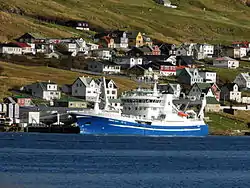Energy in the Faroe Islands
Energy in the Faroe Islands is produced primarily from fossil fuels, with further contributions from hydro and wind power. Oil products are the main energy source, mainly consumed by fishing vessels and sea transport. Electricity is produced by oil, hydropower and wind farms, mainly by the SEV, which is owned by all the municipalities of the Faroe Islands.[1] The Faroe Islands are not connected by power lines with continental Europe, and thus the archipelago cannot import or export electricity.
Overview
Per capita annual consumption of primary energy in the Faroe Islands was 67 MWh in 2011, almost 60% above the comparable consumption in continental Denmark.[2][3] After taking a dip in the early 1990s the electricity production in the Faroe Islands has steadily been on the rise since then, going from 174,422 MWh in 1994 to 314,409 MWh in 2015.[4] Wind power was introduced in 1993, producing as little as 423 MWh at first, but rising to 55,789 MWh by 2015.[4] The energy sector employed 154 people or 0.6% of the islands' total workforce as of November 2015.[5] There are several 50 kW electric vehicle charging stations on the islands.[6][7]
Electricity

The islands have 6 hydroelectric plants,[8] 4 diesel plants[9][10] and several wind power plants with a capacity factor above 40%.[11] Demand (and thus, production) is up to 55 MW in 2019 (record was 62 MW in November 2019),[12] up from 40 MW at daytime peak previously (nighttime low is 15 MW).[13]
In 2014, the DKK 180 million 12MW Húsahagi wind farm with Enercon turbines[14] became operational near Torshavn and increased wind capacity from 6.6 to 18.6MW; this decreased oil consumption by 8,000 ton (approximately 4M€) per year.[11] A 2.3MW[15] 700kWh lithium-ion battery at €2 million at Húsahagi[16][17] became operational in 2016, stabilizing the wind power output.[18][19] Wind power is expected to save consumers DKK 57 million.[20] Six Enercon E82/3MW wind turbines (18MW combined) are to be installed at Eiði, at a cost of DKK 0.239 per kWh.[21][22] A further 64 GWh per year is to be produced by a new privately owned wind farm near Torshavn.[23] Power prices increased from 0.64 per kWh in 2007, to DKK 1.31 per kWh in 2019.[24]
Planners also consider converting the existing hydropower[25] to pumped-storage hydroelectricity,[14] as rain and wind are high in winter and low in summer.[26] Tidal power,[27][28] offshore wind power[29] and thermal energy storage solutions are also being considered,[30] as the islands have a goal of 100% green electricity production by 2030.[14][31]
The municipality-owned company SEV is the main electricity supplier in the Faroe Islands with 97% of the total production, and private producers supplying the rest.[32][33] System power capacity is 100 MW oil motor, 37 MW hydropower and 18 MW wind power.[12]
Transmission
The main electricity grid on the Faroe Islands[34] has the highest voltage of 60 kiloVolt, of which there is 90 km overhead wire and 6 km cable.[35][36][37] The 20kV system is 460 km and reaches most towns in the main islands,[38] whereas the 10 kV system covers the connected outlying islands, and Torshavn.[39][40] Due to extreme weather conditions and its lack of interconnections, the Faroe Islands experience one to three total blackouts annually, a ratio higher than that of continental Europe.[41] Most of the powerlines have therefore been buried underground as cables for better protection, improving grid stability.[42] When SEV detects grid issues, automatic demand response at large consumers reduce consumption to increase grid stability.[43]
Self-contained islands
Suðuroy has its own grid[34] with 20[38] and 10 kV,[39] and is powered by the 3.3 MW Botnur power plant and 8 MW diesel at Vágur[44] and 2 MW at Trongisvágur.[45] The Faroe Islands' first solar park was installed with 250 kW capacity in Sumba in late 2019, expected to produce 160 MWh/year (equivalent to 35 tons of oil), from diffuse light for 1,000 hours per year; mainly in the summer when rain and wind are low.[46][47][48] For the month of January 2020, the plant produced 672 kWh.[49]
Seven Enercon wind turbines at a combined 6.3 MW are being installed at Porkeri Mountains, along with batteries and a syncron compensator to stabilize the grid. Production is expected to be 20 GWh per year, reducing oil consumption by 4,300 tonnes.[50][51]
Along with Suðuroy, the islands of Fugloy, Hestur, Mykines, Skúvoy and Stóra Dímun are also not part of the main grid or connected to other islands. They are each electrified through their own fossil fuel powerplants.[34][41]
Statistics
In 2018 the main electricity was 352 GWh, with 51.2% from oil engines, 30.7% from hydropower, and 18.1% from wind.[52]
In 2014 50.8% of the electricity production of SEV in the Faroe Islands came from green energy like hydro (mostly Eiði and Vestmanna)[34] and wind, while 49.2% was produced by the thermal power plants, which was 12.4% less than in 2013.[53]
- fossil fuel: 49.2%
- hydro: 39.5%
- wind: 11.3%% (2014)
- nuclear: 0%
Total annual production: 305.4 GWh (2014) of which the production of thermal, hydropower and wind power was:
- Thermal: 150,2 GWh
- Hydropower: 120,7 GWh
- Wind: 34,5 GWh
Oil consumption

In 2014, 217,547 tonnes of oil products were consumed in the Faroe Islands.[54] Of these, 31.58% was consumed by fishing vessels, 14.73% was used by SEV for electricity production, 23.23% was consumed in air, sea or land transport, 9.6% was used in the industry, and the rest was used by public or private buildings.[55]
Oil and gas exploration has been taking place around the Faroe Islands since 2001, with the expectation that significant oil reserves will be found.[56]
There are coal reserves on Suðuroy, which were considered for energy production.[33] The reserves are between 10 and 15 million tonnes and they could replace oil in the Sund power-station for 100 years.[33][34]
Government energy policy
The Faroe Islands have set a goal of producing their entire electrical energy needs from renewable energy sources by 2030.[31][57] Since energy consumption has been rising steadily during the last few decades,[4] the Ministry of Trade and Industry has conducted a study for the future development of electricity production projects.[33] Apart from the development of new hydropower plants and wind farms, the study proposes the investigation of the possibility to produce electricity from LNG and biogas.[33] The University of the Faroe Islands has undertaken research into the feasibility of tidal power at several sites which have a high energy potential,[58] leading the Ministry of Trade and Industry to consider tidal power as a possibility.[33] The privatisation of electricity production was not promoted, although consideration was given to introducing competition and transparency into electricity production.[33][34]
See also
References
- Djurhuus, Høgni; Mohr, Bjarni (17 October 2016). "Ikki umrøtt málið". Kringvarp Føroya. Retrieved 27 November 2016.
- "Total Primary Energy Consumption per Capita, Faroe Islands, Annual". Energy Information Administration. Retrieved 8 December 2015.
- "Total Primary Energy Consumption per Capita, Denmark, Annual". Energy Information Administration. Retrieved 8 December 2015.
- "Electricity production, by hydro, wind and thermal in MWh (1990-2015)". Statistics Faroe Islands. Retrieved 25 September 2016.
- "Faroe Islands in figures 2016" (PDF). Statistics Faroe Islands. 1 June 2016. Archived from the original (PDF) on 27 September 2016. Retrieved 25 September 2016.
- "Quick Charge stations in Faroe Islands". SEV.fo. 12 July 2016. Retrieved 2019-03-19.
- "Skálatrøð Tórshavn Opladningsplads". 22 June 2017. Retrieved 2019-03-19.
- Hydro electric power
- Thermal Power
- "The Plant in Sund". SEV. Retrieved 2 March 2017.
- Terji Nielsen. Wind energy in the Faroe Islands Archived 2015-12-08 at the Wayback Machine page 19-21. SEV, 2015
- "Royndarframleiðsla í nýggja partinum av Sundsverkinum". www.sev.fo. 2020-01-17.
- "The power supply system". SEV. Retrieved 22 March 2017.
- Green Progress
- "Faroe Islands to get Europe's first wind-connected battery storage system". Renew Economy.
- "The Faroe Islands Are Getting Europe's First Lithium-Ion Battery Directly Supporting Wind". GTM. 24 April 2015. Retrieved 1 March 2017.
- Taming the wind (Video). SEV.fo.
- "Lithium-ion batteries can help to safeguard the grid". 8 November 2016. Retrieved 1 March 2017.
- The Battery System in production (Video). SEV.fo. 31 May 2016.
- "Landsmyndugleikarnir avlaga kappingina um vindorkuna". www.sev.fo. 20 June 2019.
- "SEV setir vindmyllur upp á Eiði". www.sev.fo. 2 October 2019.
- "SEV wins wind tender". www.sev.fo. 2 October 2019.
- Leo, Jens Hákun (2 October 2019). "P/F Magn gains license to build and operate Tórshavn-based windmill park". Local.fo.
- Hermansdóttir Eidesgaard, Marin (16 January 2020). "High electricity prices "an obstacle for industry"". Kringvarp Føroya (in Faroese).
- Bárður A. Niclasen. Vedvarende energi Archived 2015-12-08 at the Wayback Machine 2015
- "Tangible plan for the green course". www.sev.fo. 16 May 2017. Retrieved 12 November 2017.
Precipitation and wind speeds decrease as we enter the summer period + diagram
- Tidal Energy on the Horizon
- "Tidal energy project". www.sev.fo. 2019-08-22.
- "Føroya fyrsta sjóvindmyllulund". www.sev.fo. 16 September 2020.
- Jannicke Nilsen (27 November 2015). "ENERGYNEST - THERMAL ENERGY STORAGE - TES". Teknisk Ukeblad.
- "100by2030". SEV. Retrieved 1 March 2017.
- "Faroese Energy – On the Sustainability Track". faroeislands.fo - The official gateway to the Faroe Islands. Archived from the original on 27 August 2016. Retrieved 8 November 2016.
- "Comprehensive Plan for Electric Energy in the Faroe Islands" (PDF). Ministry of Trade and Industry. 11 August 2011. Retrieved 19 March 2019.
- Mikladal, Poul A. (December 2005). "Sustainable energy in the Faroe Islands - the role of hydropower" (PDF). Faroese Prime Minister's Office. pp. 15–16. Retrieved 1 March 2017.
- "The 60 kV Power Supply System". SEV. Retrieved 2 March 2017.
- 60kV map
- "Distribution Units". SEV. Retrieved 2 March 2017.
- "The 20 kV Power Supply System". SEV. Retrieved 2 March 2017.
- "The 10 kV Power Supply System". SEV. Retrieved 2 March 2017.
- 10 kV map
- Birke, Anders (28 May 2015). "The Faroe Islands - Solutions for integrating a large share of renewables" (PDF). European Commission. Retrieved 8 December 2015.
- "The majority of the power grid is now underground". www.sev.fo. 24 March 2014. Retrieved 12 November 2017.
- "Power Hub a Success". SEV. Retrieved 25 December 2017.
- "The Plant in Vágur". SEV. Retrieved 2 March 2017.
- "The Plant in Trongisvágur". SEV. Retrieved 2 March 2017.
- "Elfelagið SEV - Sólorka í Sumba". www.sev.fo. 31 October 2019.
- "One step closer to solar power in Sumba". www.sev.fo. 2019-06-25.
- "First field solar PV plant in the Faroes inaugurated". www.sev.fo. 3 December 2019.
- "Grønur januar". www.sev.fo. 5 February 2020.
- "Skjøtil settur á vindmyllulund í Porkerishaganum". www.sev.fo. 13 January 2020.
- "Porkeri Wind Farm taking shape". www.sev.fo. 10 August 2020.
- "Green electrical power production almost 49% in 2018". www.sev.fo. 2019-02-08.
- "SEV - Framleiðsluroknskapur 2014 Production Accounts 2014" (PDF) (in Faroese and English). SEV. Retrieved 25 September 2015.
- "Consumption of oil in tonnes, total 1992-2017". Statistics Faroe Islands. Retrieved 24 March 2019.
- "Consumption of oil in tonnes by consumer groups 1992-2017". Statistics Faroe Islands. Retrieved 24 March 2019.
- Topdahl, Rolv Christian (24 August 2012). "Oil can turn the Faroe Islands into the new Kuwait". Aftenbladet. Retrieved 25 September 2016.
- Deign, Jason (24 April 2015). "The Faroe Islands Are Getting Europe's First Lithium-Ion Battery Directly Supporting Wind". Greentech Media. Retrieved 22 February 2016.
- Simonsen, Knud; Niclasen, Bárður (1 May 2011). "On the energy potential in the tidal streams on the Faroe Shelf" (PDF). University of the Faroe Islands. Archived from the original (PDF) on 2016-11-09. Retrieved 8 November 2016.
